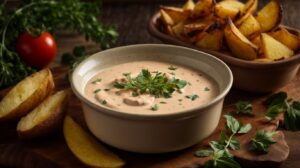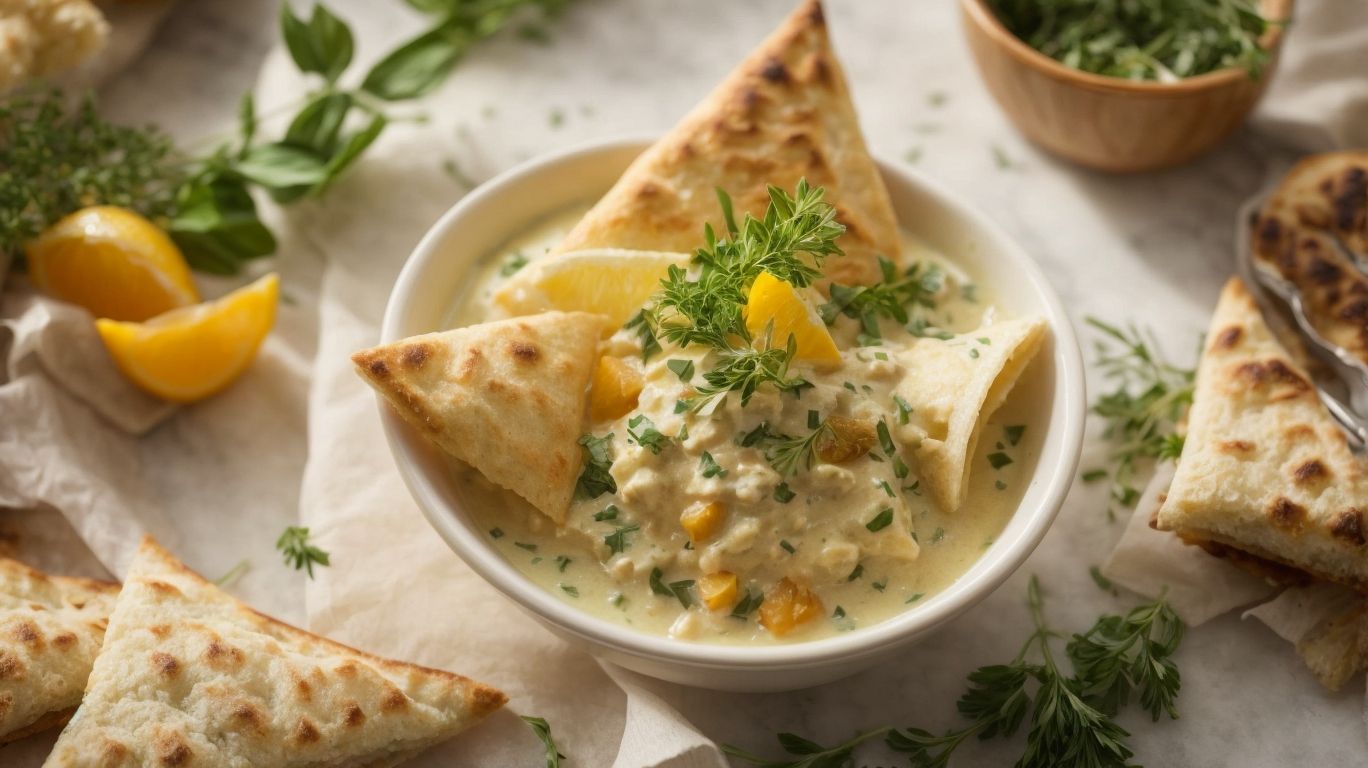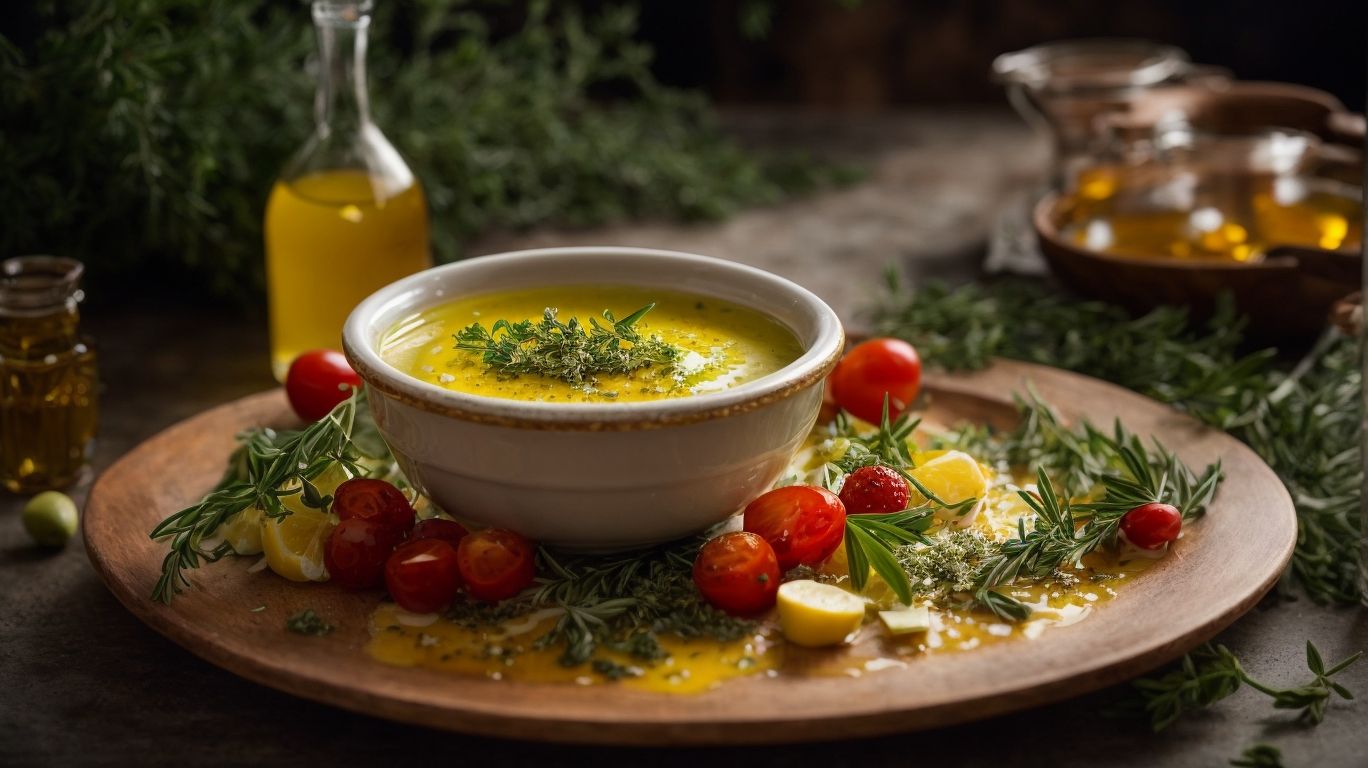
Skordalia, a garlicky culinary gem, is a traditional Greek dish that has been enjoyed for centuries. This flavorful sauce or dip is made from a base of mashed garlic and potatoes or almonds, resulting in a creamy and aromatic delicacy.
What is Skordalia?
Skordalia is a Greek sauce or dip that is known for its strong garlic flavor and creamy texture. It is typically made by blending garlic with either mashed potatoes or ground almonds, along with olive oil, vinegar or lemon juice, and sometimes bread or nuts for added texture. Skordalia is often seasoned with salt, pepper, and herbs like parsley or dill.
What is the Origin of Skordalia?
Skordalia is a much-loved traditional Greek dish that has been passed down through generations. It is a popular favorite in Greek cuisine and is often served as an appetizer or as a side dish to main courses. The dish is believed to have originated in ancient Greece and has since become a culinary gem enjoyed by many.
Traditional Recipe
Ingredients:
- 6 cloves of garlic
- 2 large potatoes, boiled and mashed (or 1 cup of ground almonds)
- 1/2 cup of extra virgin olive oil
- 2 tablespoons of white vinegar or lemon juice
- Salt and pepper to taste
- Chopped parsley or dill for garnish (optional)
Instructions:
- In a food processor or mortar and pestle, crush the garlic cloves until they form a smooth paste.
- If using potatoes, peel and boil them until soft. Mash the potatoes until smooth.
If using almonds, grind them until they form a fine powder. - In a bowl, combine the garlic paste with the mashed potatoes or ground almonds.
- Slowly drizzle in the olive oil while continuously mixing, until the mixture becomes creamy and well blended.
- Add the vinegar or lemon juice, salt, and pepper to taste. Adjust the seasonings according to your preference.
- Transfer the skordalia to a serving dish and garnish with chopped parsley or dill, if desired.
- Serve the skordalia at room temperature or chilled, allowing the flavors to meld together.
Variations
While the traditional recipe uses potatoes or almonds as the base, there are variations of skordalia that incorporate different ingredients to add flavor and texture.
1. Potato Skordalia: This is the classic version of skordalia, using boiled and mashed potatoes as the main ingredient. The potatoes create a smooth and creamy texture for the dip.
2. Almond Skordalia: In this variation, ground almonds are used instead of potatoes. The almonds add a nutty flavor and a slightly grainy texture to the skordalia.
How is Skordalia Served?
Skordalia can be enjoyed in various ways, depending on personal preferences and culinary traditions.
1. Meze or Appetizer: Skordalia is commonly served as a meze or appetizer in Greek cuisine. It is served alongside other small dishes, such as pita bread, olives, or grilled vegetables. It is usually spread on bread or used as a dip for vegetables.
2. Accompaniment to Main Dishes: Skordalia can also be served as a condiment or accompaniment to main dishes. It pairs well with grilled meats, roasted vegetables, or fried seafood. The creamy and garlicky flavor of skordalia complements a wide range of savory dishes.
Health Benefits of Skordalia
Beyond its delicious taste, skordalia offers some health benefits as well.
1. Garlic’s Anti-inflammatory Properties: Garlic, a primary ingredient in skordalia, contains compounds with anti-inflammatory properties. It may help reduce inflammation in the body and support overall health.
2. Nutritional Value of Potatoes/Almonds: Skordalia made with potatoes provides dietary fiber and essential nutrients like potassium and vitamin C. Almond-based skordalia offers a good source of healthy fats, protein, and vitamin E. Both variations can be a nutritious addition to a balanced diet.
Key takeaways:
- Authentic Greek delight: Skordalia is a traditional Greek garlic sauce that adds a flavorful punch to any dish.
- Versatile and easy to make: Skordalia comes in various versions, such as potato or almond-based, and can be served as a dip, spread, or accompaniment.
- Healthy and nutritious: Skordalia offers health benefits like anti-inflammatory properties from garlic and nutritional value from potatoes or almonds.
What is Skordalia?

Photo Credits: Cookingwithgreekpeople.Com by Noah Gonzalez
What is Skordalia?
Skordalia is a traditional Greek dish known for its garlicky and creamy texture. It is typically made with mashed potatoes or bread crumbs, garlic, olive oil, and vinegar or lemon juice. Skordalia can be served as a dip or as a side dish with fish, meat, or vegetables. It is a versatile and flavorful addition to any meal. Pro-tip: To enhance the taste of skordalia, let it sit for a few hours before serving, allowing the flavors to blend and intensify.
What is the Origin of Skordalia?
Skordalia, a popular Greek dish, has a rich and ancient origin. The origin of Skordalia is believed to be in ancient Greece. Originally, Skordalia was made with pounded almonds and garlic, and it was served as a sauce or dip. Over time, potatoes were introduced as a main ingredient, making it more accessible to the general population. Today, there are variations of Skordalia made with different ingredients such as bread, walnuts, or even beets. Skordalia is often served as a meze or appetizer, or as an accompaniment to main dishes. Its health benefits include the anti-inflammatory properties of garlic and the nutritional value of potatoes or almonds. So, to answer the question “What is the Origin of Skordalia?”, Skordalia is believed to have originated in ancient Greece.
Traditional Skordalia Recipe

Photo Credits: Cookingwithgreekpeople.Com by Douglas Carter
Indulge in the culinary delight of Traditional Skordalia Recipe, a mouthwatering Greek delicacy that will transport your taste buds to the vibrant streets of Greece. Discover the tantalizing combination of ingredients and step-by-step instructions that make this dish an irresistible treat. Unleash the flavors of Skordalia as we delve into the world of authentic Greek cuisine. Get ready to savor the garlicky goodness and unlock the secrets to recreating this gem in your own kitchen.
Ingredients
Skordalia, a Greek garlic-based dip, incorporates a combination of ingredients that are both simple and flavorful. Here is a table that showcases the ingredients commonly used in skordalia:
| Potatoes | Garlic | Olive Oil | Vinegar or Lemon Juice | Almonds (for almond skordalia) |
These ingredients make skordalia rich in flavor and provide various health benefits. Potatoes provide essential nutrients, garlic has anti-inflammatory properties, and olive oil adds healthy fats. The tanginess of vinegar or lemon juice complements the dish. For a twist, almonds can be used instead of potatoes. Skordalia’s simple yet delicious ingredients make it a versatile and popular addition to Greek cuisine.
Instructions
To prepare traditional skordalia, follow these instructions:
1. Begin by peeling and boiling 500 grams of potatoes until they are tender. Once cooked, drain the potatoes and mash them in a mixing bowl.
2. Take 4 cloves of garlic and crush them with a pinch of salt using a mortar and pestle. Continue until the garlic forms a smooth paste.
3. Next, add the garlic paste to the mashed potatoes. Also, include 2 tablespoons of white wine vinegar and 1/2 cup of extra virgin olive oil in the mixing bowl.
4. Thoroughly mix all the ingredients together until they are fully combined and the skordalia achieves a creamy consistency.
5. Now, season with salt and pepper according to your taste preferences.
6. Finally, serve the skordalia chilled or at room temperature as a delightful dip or as a tasty side dish.
Pro-tip: For an even creamier texture, you can try replacing half of the potatoes with blanched almonds. Indulge in the rich flavors of this delicious Greek garlic dip!
Variations

Photo Credits: Cookingwithgreekpeople.Com by Nicholas Perez
Discover the wonderful world of variations in Skordalia, the garlicky culinary gem from Greece. Dive into the flavors and textures of Potato Skordalia and Almond Skordalia, each offering a unique twist to this beloved dish. From creamy potato blends to nutty almond infusions, these sub-sections will take you on a mouthwatering journey through the diverse interpretations of Skordalia. Get ready to savor the delights that await in this tantalizing exploration of Greek cuisine.
1. Potato Skordalia
Potato Skordalia is a traditional Greek dish that showcases the flavors of mashed potatoes, garlic, olive oil, and vinegar. This versatile and delicious side dish can complement a variety of main dishes or be enjoyed as a flavorful appetizer. The recipe for Potato Skordalia typically calls for boiled potatoes, garlic cloves, olive oil, white bread, vinegar, and salt. These ingredients are skillfully mashed together to create a creamy and flavorful dip. Renowned for its rich and garlicky taste, Potato Skordalia is a beloved choice among garlic enthusiasts. Its smooth and tangy texture makes it a perfect accompaniment to grilled meats, seafood, or vegetables.
2. Almond Skordalia
To prepare almond skordalia, gather the following ingredients: blanched almonds, garlic cloves, stale bread, white wine vinegar, olive oil, salt, and water.
| Ingredients: | Blanched almonds | Garlic cloves | Stale bread | White wine vinegar | Olive oil | Salt | Water |
| Amount: | 1 cup | 4 cloves | 2 slices | 2 tsp | 1/3 cup | To taste | 1/2 cup |
Instructions:
- Soak the bread slices in water and then squeeze out the excess water.
- Blend the almonds, garlic, and soaked bread until smooth.
- Gradually add vinegar, olive oil, salt, and water while blending.
- Adjust the consistency by adding more water if necessary.
- Transfer the almond skordalia to a bowl, cover, and refrigerate for at least an hour to allow the flavors to meld.
Enjoy almond skordalia as a tasty dip or spread with various dishes.
How is Skordalia Served?

Photo Credits: Cookingwithgreekpeople.Com by James Campbell
How do you enjoy the mouthwatering Greek delight known as skordalia? Let’s dig into the various ways this garlicky culinary gem is served. From being a tantalizing meze or appetizer to a delectable accompaniment to main dishes, skordalia adds a burst of flavor to any meal. Whether you’re a fan of traditional Greek cuisine or looking to discover new tastes, the different serving styles of skordalia will leave you craving for more. Get ready to indulge in this irresistible delicacy!
1. Meze or Appetizer
Skordalia is a versatile Greek dish that can be served as a meze or appetizer. It is made from a base of mashed potatoes or almonds and flavored with garlic, olive oil, and vinegar. Skordalia is traditionally served with bread or vegetables as a dip. It is a popular choice for starting a meal or as part of a spread of Mediterranean appetizers. The garlic in skordalia not only adds a delicious flavor, but it also has anti-inflammatory properties. Potatoes and almonds used in skordalia are nutrient-rich, providing a range of health benefits.
| 1. Meze or Appetizer |
2. Accompaniment to Main Dishes
Skordalia, a versatile accompaniment to main dishes, is a garlicky Greek dip. Indulge in the comforting combination of creamy potato skordalia with grilled meat. The beautifully roasted vegetables are enhanced by the nutty flavor of almond skordalia. To enjoy a classic pairing, dip fried seafood into the traditional skordalia. And when savoring braised lamb, relish the delicious contrast provided by the garlic-infused skordalia. With its rich flavors and creamy texture, skordalia enhances a variety of main courses, creating a delightful experience with every bite.
In a remote Greek village, a festive meal brings a family together around the table. The matriarch serves a platter of slow-roasted lamb, accompanied by a generous bowl of skordalia. Laughter and chatter fill the air as they gather. Everyone savors the tender lamb, dipping it into the creamy skordalia. Memories are made, and traditions are passed down through generations with each bite. The skordalia, symbolizing love and togetherness, brings joy to their hearts and completes the meal in the most delicious way.
Health Benefits of Skordalia

Photo Credits: Cookingwithgreekpeople.Com by Christopher Ramirez
Indulging in the garlicky delight of Skordalia isn’t just a treat for your taste buds; it also brings a host of health benefits to the table. In this section, we’ll uncover the secrets behind Skordalia’s positive impact on our well-being. Discover the anti-inflammatory properties of garlic and the nutritional value packed within potatoes and almonds. Get ready to savor the flavors while nourishing your body from the inside out!
1. Garlic’s Anti-inflammatory Properties
Garlic’s anti-inflammatory properties are widely known for their potent flavor and numerous health benefits. Research studies have demonstrated that garlic contains compounds, such as allicin, which can effectively reduce inflammation in the body. These compounds have been found to inhibit the production of specific inflammatory enzymes. By incorporating garlic into your diet, such as using it in dishes like Skordalia, you can promote a healthy inflammatory response and support your overall well-being.
My uncle, who suffered from chronic arthritis, made a positive change by incorporating garlic into his daily meals. Over time, he experienced a significant reduction in joint pain and inflammation. Inspired by his success, I have also started using garlic more frequently in my cooking and have noticed improvements in my overall well-being. It’s clear that garlic is a true culinary gem that offers amazing health benefits.
2. Nutritional Value of Potatoes/Almonds
Potatoes and almonds both contribute to the nutritional value of skordalia, a traditional Greek dish. The following table displays the nutritional contents of these key ingredients:
| Nutrient | Potatoes (100g) | Almonds (100g) |
|---|---|---|
| Calories | 77 | 576 |
| Carbohydrates | 17g | 21g |
| Protein | 2g | 21g |
| Fat | 0.1g | 49g |
| Fiber | 2.2g | 12g |
Incorporating potatoes into skordalia adds beneficial carbohydrates and dietary fiber, while almonds contribute protein and healthy fats. This combination not only makes skordalia a satisfying dish but also enhances its nutritional value. For an extra burst of flavor, consider using roasted almonds. Whether enjoyed as a dip or a condiment, skordalia is a Greek culinary gem that offers both deliciousness and nourishment.
Some Facts About Savoring Skordalia Greece Garlicky Culinary Gem:
- ✅ Skordalia is a Greek garlic-potato-nut mash. (Source: Our Team)
- ✅ The base ingredient of skordalia is garlic. (Source: Our Team)
- ✅ Potatoes are rinsed before and after cooking to reduce their starchiness in skordalia. (Source: Our Team)
- ✅ Skordalia can be served as a side dish or spread. (Source: Our Team)
- ✅ Traditional skordalia recipes may also include nuts such as walnuts or almonds. (Source: Our Team)
Frequently Asked Questions
What is Skordalia?
Skordalia is a Greek garlic-potato-nut mash that can be served as a side dish or spread. It is a traditional Greek dish with garlic as the base ingredient.
What are the main ingredients in Skordalia?
The main ingredients in Skordalia include potatoes, garlic, nuts (such as walnuts or almonds), olive oil, and citrus (lemon juice or red wine vinegar). These ingredients are combined to create a flavorful and creamy dip or side dish.
How do you make Skordalia?
To make Skordalia, peel and dice the potatoes, then boil them until tender. Rinse and mash the cooked potatoes, and set them aside. In a food processor or mortar and pestle, blend garlic, nuts, citrus, and olive oil into a paste. Combine the garlic-almond mixture with the mashed potatoes and mix well. Skordalia can be served warm or chilled, and garnished with parsley or other herbs.
Can Skordalia be served as a dip?
Yes, Skordalia can be served as a dip with pita bread or as a spread on sandwiches. It adds a garlicky and nutty flavor to any dish it accompanies.
What are some common cooking mistakes when making Skordalia?
One common mistake when making Skordalia is over-mixing the potatoes, which can make them sticky and starchy. It is recommended to mash the potatoes using a ricer or masher with holes to avoid this. Additionally, not properly rinsing and drying the potatoes before mashing can result in a less desirable texture.
How can Skordalia be used in a Greek meal?
Skordalia can be served as a side dish, especially with fish or grilled souvlaki. It can also be enjoyed as a dip with pita bread or as a creamy spread on sandwiches. Skordalia adds a delicious garlicky and nutty flavor to any Greek meal.
References:
Embedded Internal Links
- Greek Salad Recipe
- Greek Lemon Chicken
- Manuka Honey Health Benefits
- Vegetarian Recipes
- Greek Christmas Traditions
- Refreshing Mediterranean Greek Salad
- Best Greek Cheeses
- Greek Yogurt Benefits
- Greek Food Festivals
- Greek Language and Culture
- Tradition of Greek Breads


















